Goal-setting is a critical component of successful business and personal endeavors. While there are various approaches to setting goals, one method that has proven to be highly effective over the years is the SMART goal methodology. But what exactly are SMART goals? And why are they essential in a work environment? Let's explore these concepts in-depth and learn 10 SMART goals examples for work.
What Are SMART Goals
SMART is an acronym that stands for Specific, Measurable, Achievable, Relevant, and Time-bound. It provides a comprehensive framework for setting objectives that are clear, attainable, and designed to drive progress and motivation.
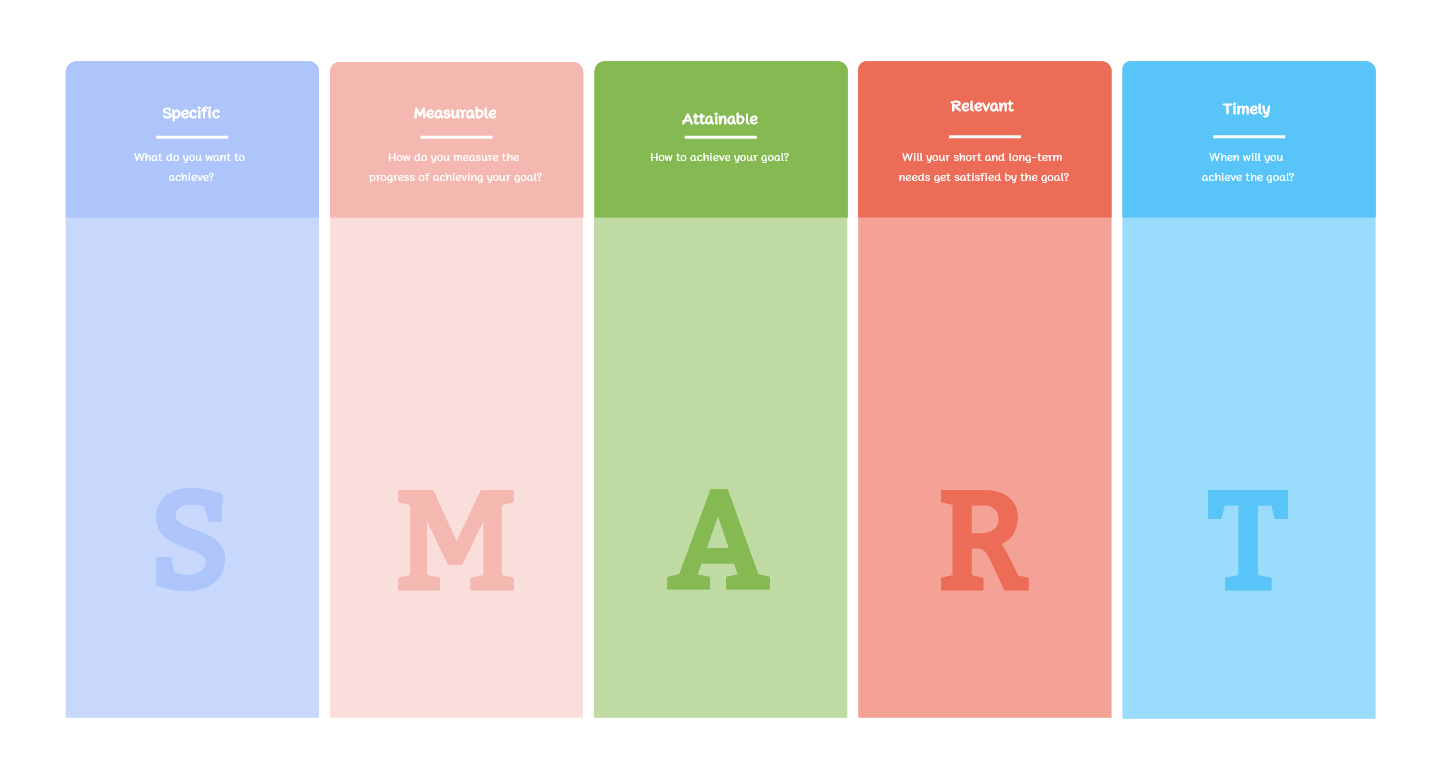
- Specific: A SMART goal must be clear and specific. Rather than broad generalizations, it should delineate exactly what is expected, why it's essential, and how you plan to achieve it.
- Measurable: It's crucial to have concrete criteria for measuring progress. This helps you stay on track, reach your target dates, and experience the exhilaration of achievement.
- Achievable: Your goal must be attainable—not something that's out of reach. While it should push you out of your comfort zone, it must remain realistic and manageable.
- Relevant: The goal should align with broader business objectives. It needs to matter to the organization and help drive it forward.
- Time-bound: Every goal needs a deadline. This provides a sense of urgency and prompts action, thereby ensuring progress.
Why Are SMART Goals Important for Work
SMART goals play a pivotal role in work environments, driving efficiency, productivity, and motivation.
- Clarity and Direction: By specifying what needs to be achieved and setting out a roadmap for success, SMART goals offer a clear direction. Employees understand what is expected of them, thus enhancing their focus and performance.
- Measurement and Feedback: With the 'measurable' component of SMART goals, it becomes possible to track progress and make adjustments if required. This also allows for timely feedback, which is vital for continuous improvement.
- Realistic Objectives: Since SMART goals must be achievable, they set realistic expectations. This boosts employees' confidence as they know that their goals are within reach.
- Alignment with Organizational Objectives: The 'relevant' aspect ensures that individual or team goals align with the company's strategic objectives. This creates cohesion and unity in working towards common organizational targets.
- Timely Completion: Lastly, SMART goals ensure timely completion of tasks by creating a sense of urgency with time-bound targets.
Thus, by adopting SMART goal methodology at work, organizations can create a motivated workforce that effectively contributes towards achieving strategic objectives.
10 Detailed SMART Goals Examples for Work
Setting SMART goals can lead to remarkable productivity and success in the workplace. Here are ten examples that demonstrate how to apply the SMART criteria in various work-related contexts:
SMART Goals Example for Work - 01
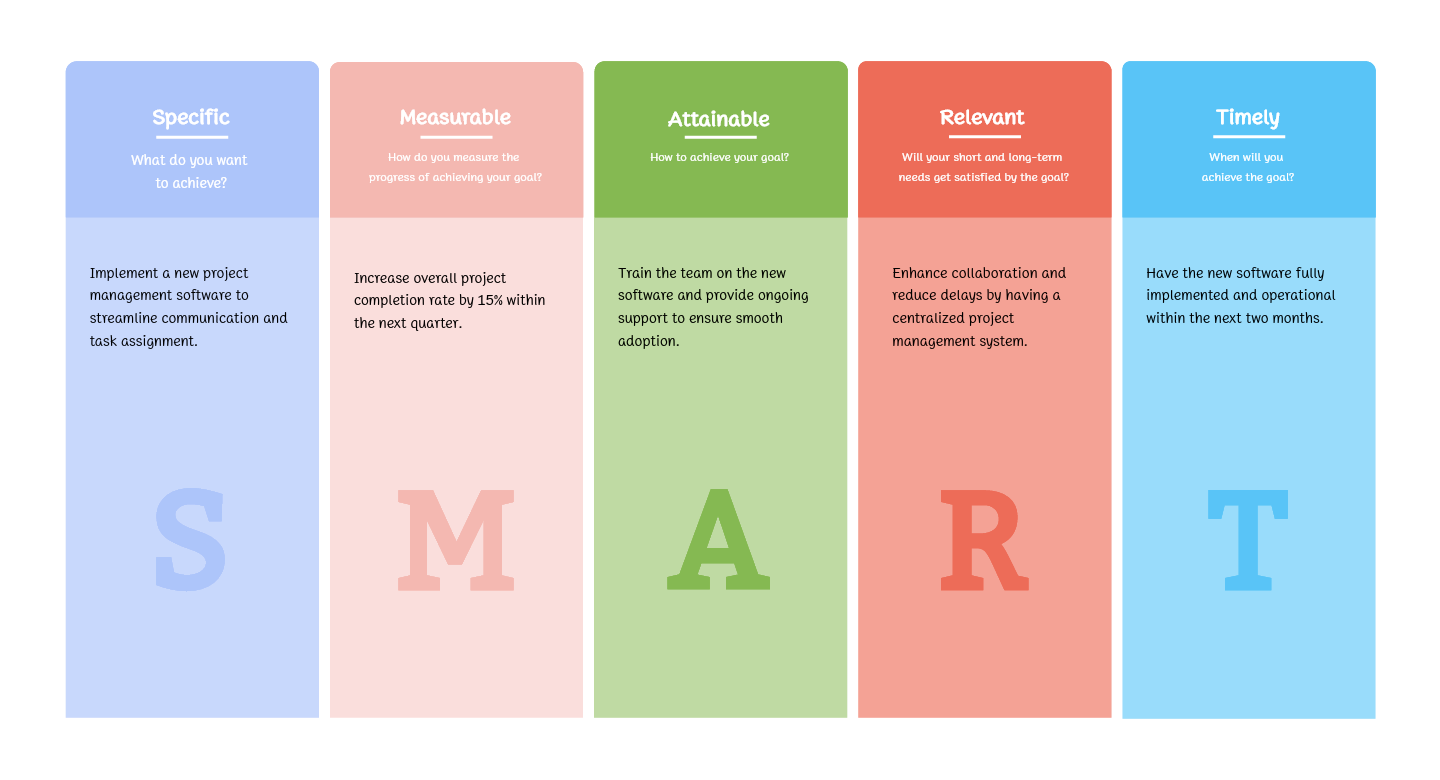
General Goal: Improve Project Management Efficiency
- Specific (S): Implement a new project management software to streamline communication and task assignment.
- Measurable (M): Increase overall project completion rate by 15% within the next quarter.
- Achievable (A): Train the team on the new software and provide ongoing support to ensure smooth adoption.
- Relevant (R): Enhance collaboration and reduce delays by having a centralized project management system.
- Time-bound (T): Have the new software fully implemented and operational within the next two months.
SMART Goals Example for Work - 02
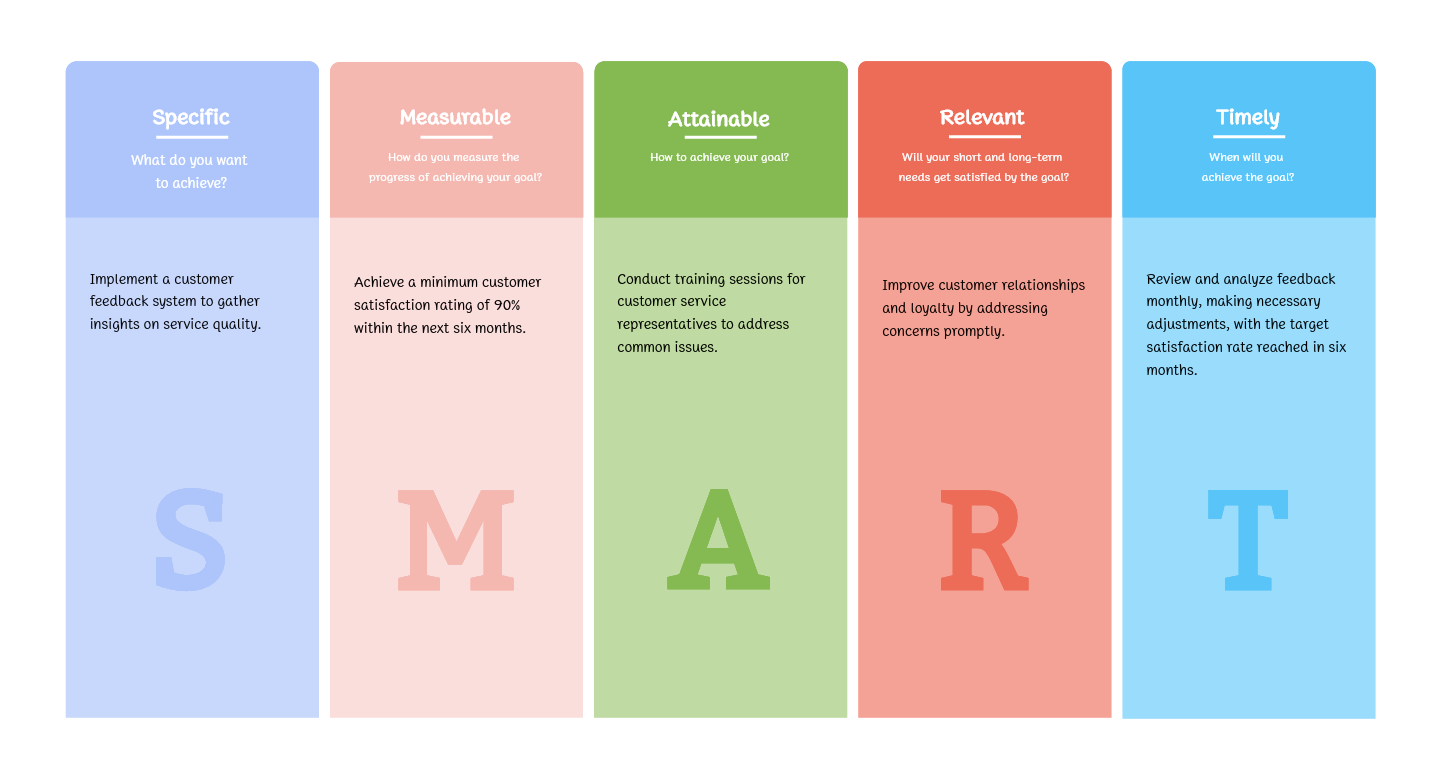
General Goal: Enhance Customer Satisfaction
- Specific (S): Implement a customer feedback system to gather insights on service quality.
- Measurable (M): Achieve a minimum customer satisfaction rating of 90% within the next six months.
- Achievable (A): Conduct training sessions for customer service representatives to address common issues.
- Relevant (R): Improve customer relationships and loyalty by addressing concerns promptly.
- Time-bound (T): Review and analyze feedback monthly, making necessary adjustments, with the target satisfaction rate reached in six months.
SMART Goals Example for Work - 03
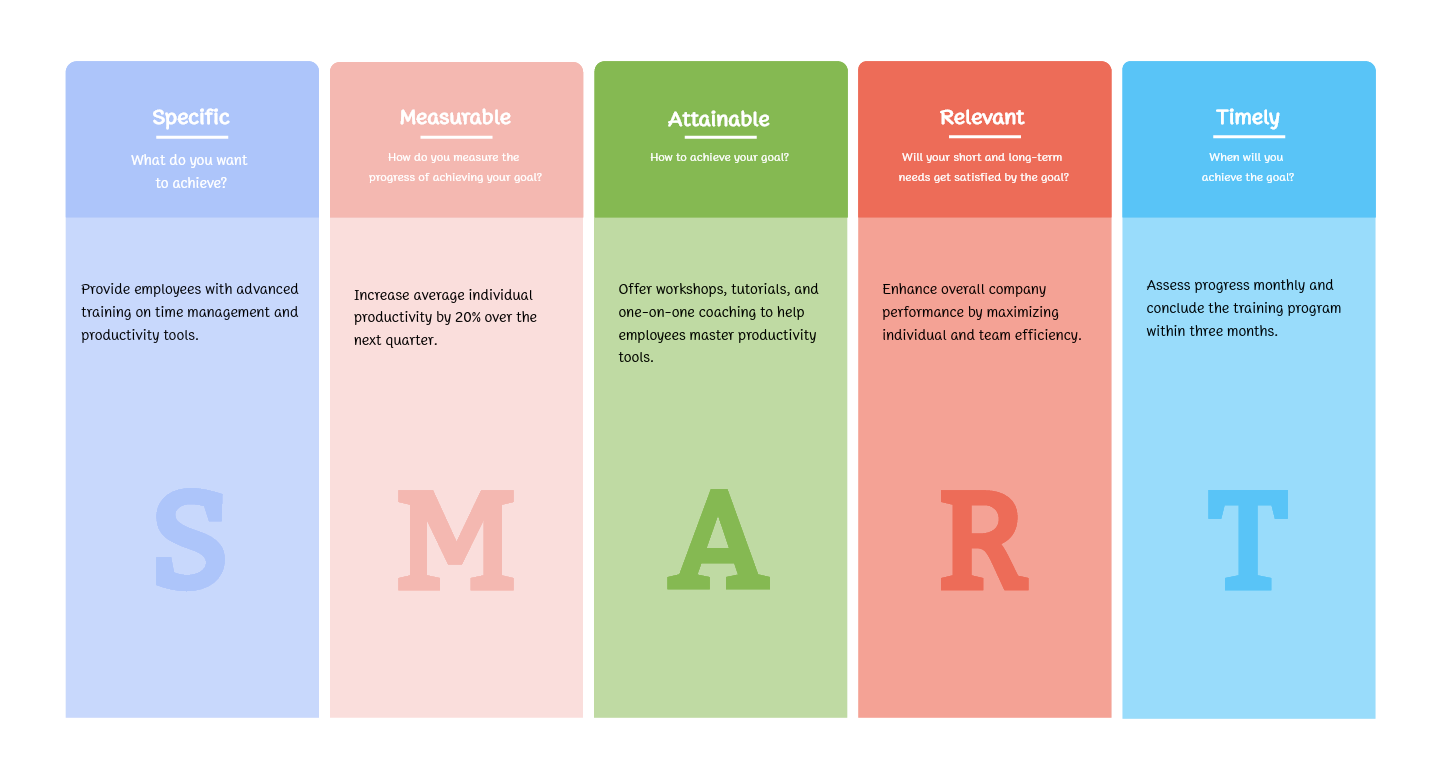
General Goal: Boost Employee Productivity
- Specific (S): Provide employees with advanced training on time management and productivity tools.
- Measurable (M): Increase average individual productivity by 20% over the next quarter.
- Achievable (A): Offer workshops, tutorials, and one-on-one coaching to help employees master productivity tools.
- Relevant (R): Enhance overall company performance by maximizing individual and team efficiency.
- Time-bound (T): Assess progress monthly and conclude the training program within three months.
SMART Goals Example for Work - 04
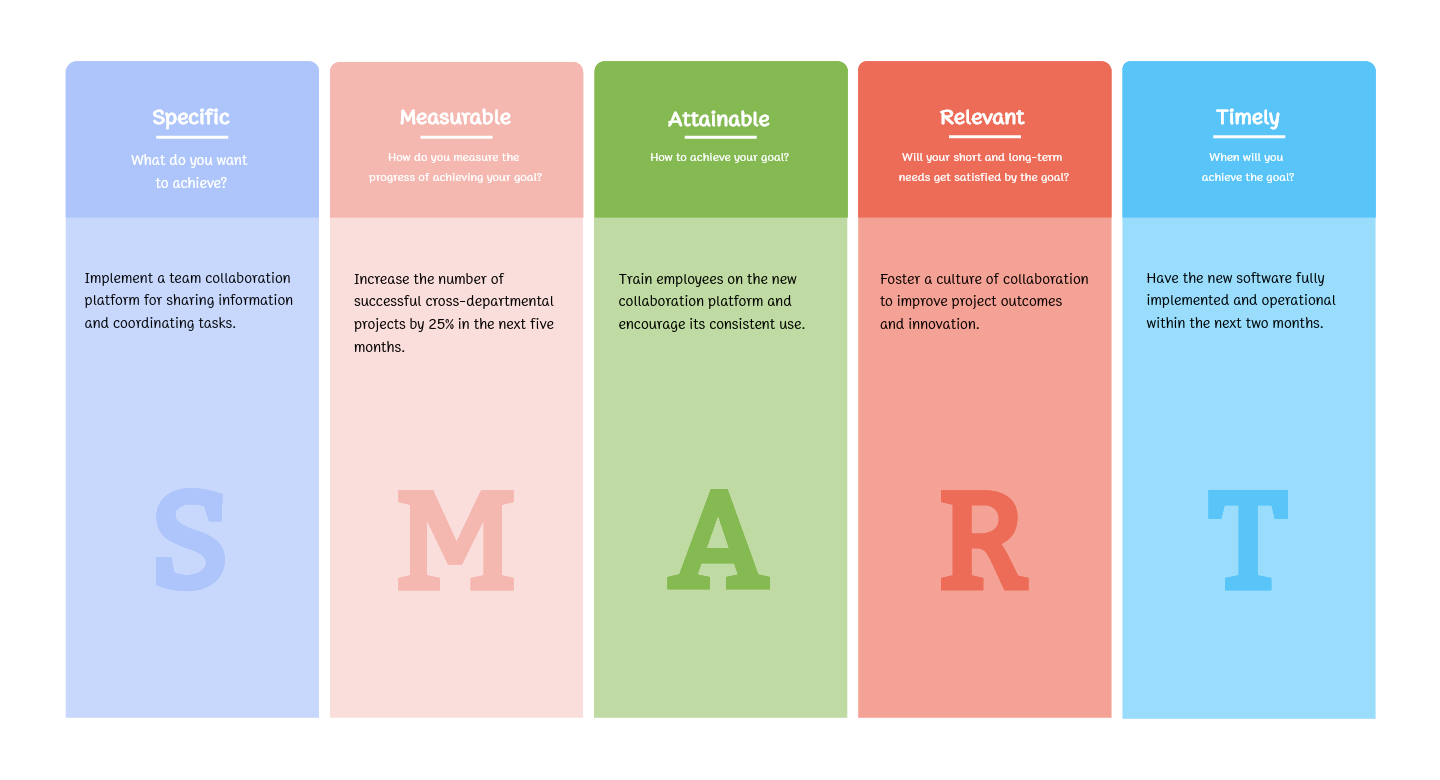
General Goal: Strengthen Team Collaboration
- Specific (S): Implement a team collaboration platform for sharing information and coordinating tasks.
- Measurable (M): Increase the number of successful cross-departmental projects by 25% in the next five months.
- Achievable (A): Train employees on the new collaboration platform and encourage its consistent use.
- Relevant (R): Foster a culture of collaboration to improve project outcomes and innovation.
- Time-bound (T): Have the collaboration platform fully integrated and operational within the next two months.
SMART Goals Example for Work - 05
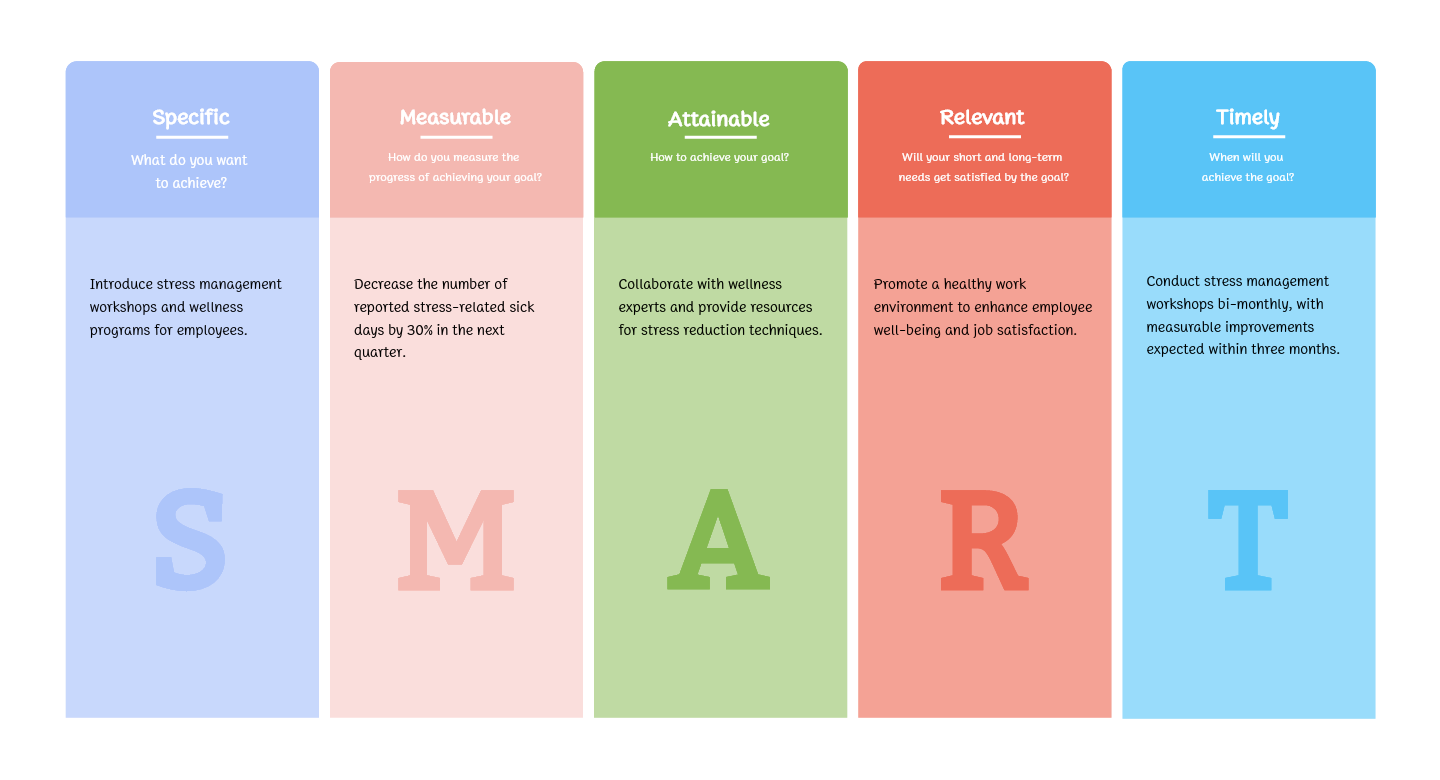
General Goal: Reduce Workplace Stress
- Specific (S): Introduce stress management workshops and wellness programs for employees.
- Measurable (M): Decrease the number of reported stress-related sick days by 30% in the next quarter.
- Achievable (A): Collaborate with wellness experts and provide resources for stress reduction techniques.
- Relevant (R): Promote a healthy work environment to enhance employee well-being and job satisfaction.
- Time-bound (T): Conduct stress management workshops bi-monthly, with measurable improvements expected within three months.
SMART Goals Example for Work - 06

General Goal: Increase Sales Revenue
- Specific (S): Launch a targeted marketing campaign to generate new leads and increase sales.
- Measurable (M): Achieve a 15% increase in sales revenue within the next six months.
- Achievable (A): Invest in digital marketing strategies and provide sales training for the team.
- Relevant (R): Drive business growth by expanding the customer base and increasing sales opportunities.
- Time-bound (T): Monitor campaign performance weekly, making adjustments as needed, with the target revenue increase realized in six months.
SMART Goals Example for Work - 07
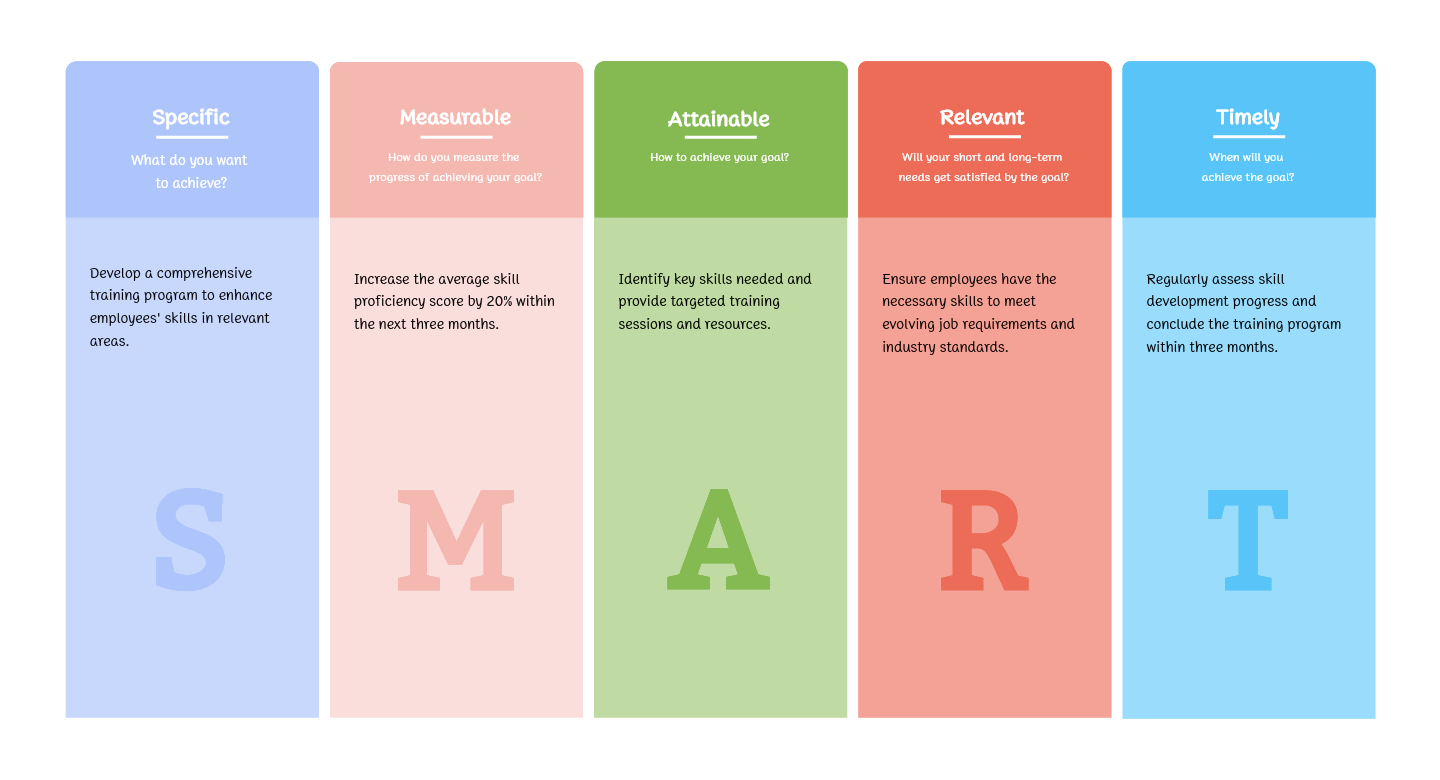
General Goal: Improve Employee Skillset
- Specific (S): Develop a comprehensive training program to enhance employees' skills in relevant areas.
- Measurable (M): Increase the average skill proficiency score by 20% within the next three months.
- Achievable (A): Identify key skills needed and provide targeted training sessions and resources.
- Relevant (R): Ensure employees have the necessary skills to meet evolving job requirements and industry standards.
- Time-bound (T): Regularly assess skill development progress and conclude the training program within three months.
SMART Goals Example for Work - 08
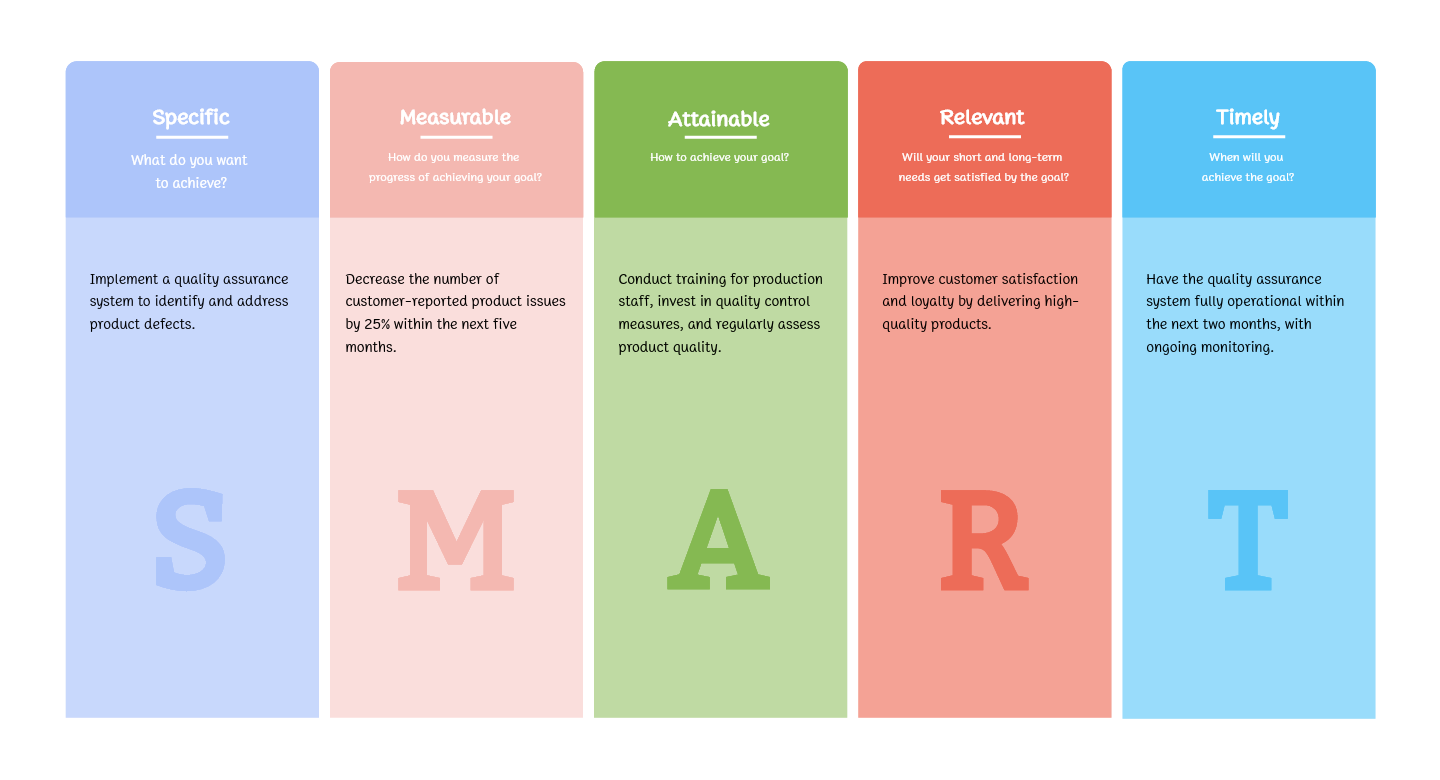
General Goal: Enhance Product Quality
- Specific (S): Implement a quality assurance system to identify and address product defects.
- Measurable (M): Decrease the number of customer-reported product issues by 25% within the next five months.
- Achievable (A): Conduct training for production staff, invest in quality control measures, and regularly assess product quality.
- Relevant (R): Improve customer satisfaction and loyalty by delivering high-quality products.
- Time-bound (T): Have the quality assurance system fully operational within the next two months, with ongoing monitoring.
SMART Goals Example for Work - 09
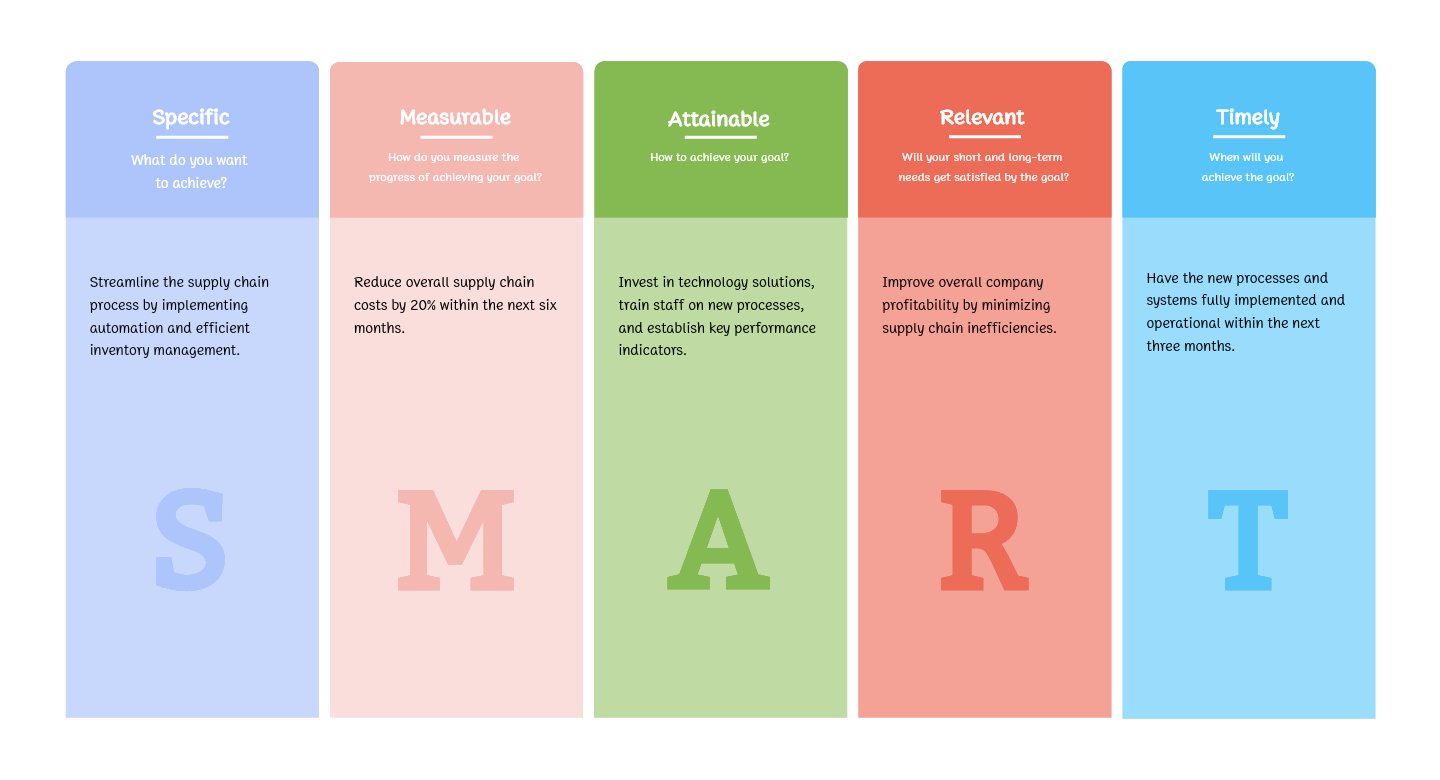
General Goal: Optimize Supply Chain Efficiency
- Specific (S): Streamline the supply chain process by implementing automation and efficient inventory management.
- Measurable (M): Reduce overall supply chain costs by 20% within the next six months.
- Achievable (A): Invest in technology solutions, train staff on new processes, and establish key performance indicators.
- Relevant (R): Improve overall company profitability by minimizing supply chain inefficiencies.
- Time-bound (T): Have the new processes and systems fully implemented and operational within the next three months.
SMART Goals Example for Work - 10
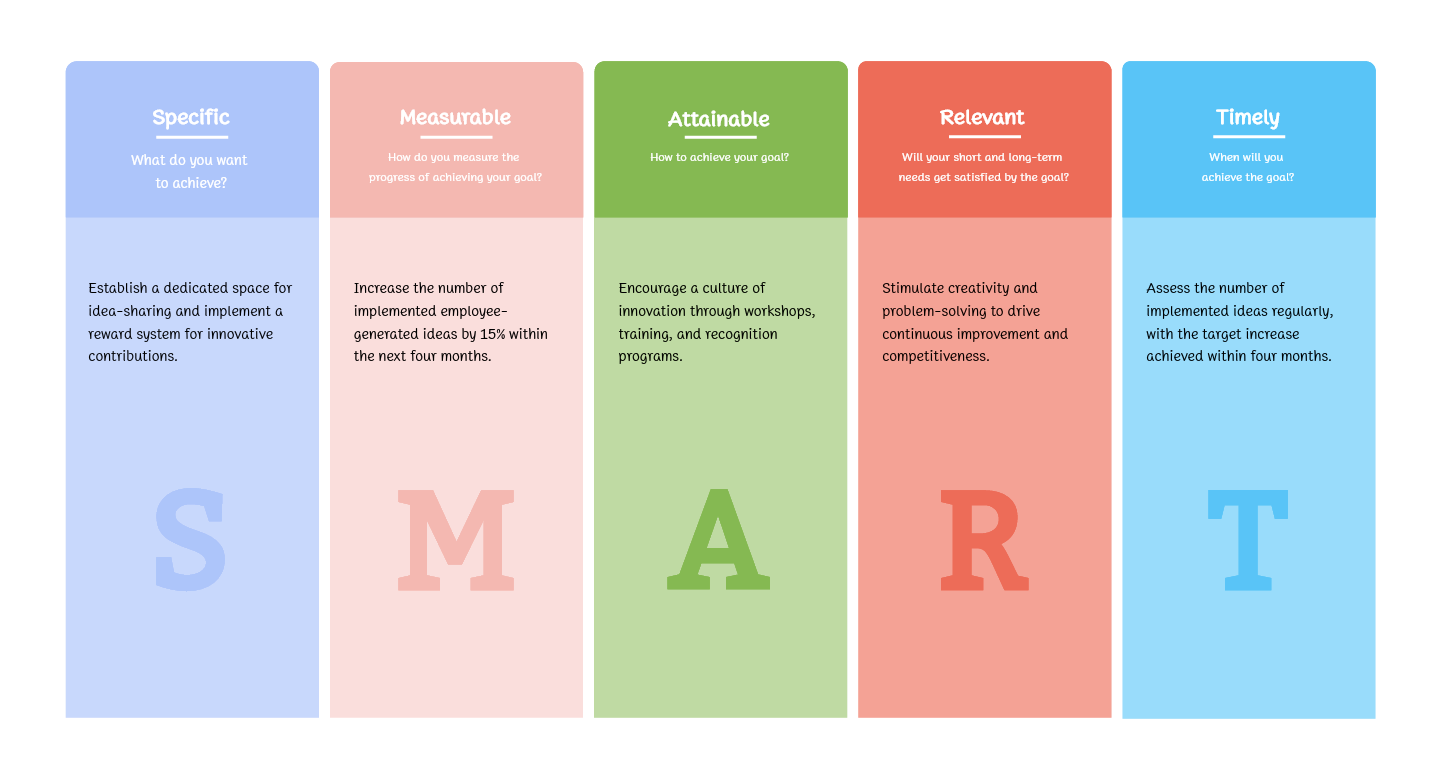
General Goal: Foster Innovation within the Team
- Specific (S): Establish a dedicated space for idea-sharing and implement a reward system for innovative contributions.
- Measurable (M): Increase the number of implemented employee-generated ideas by 15% within the next four months.
- Achievable (A): Encourage a culture of innovation through workshops, training, and recognition programs.
- Relevant (R): Stimulate creativity and problem-solving to drive continuous improvement and competitiveness.
- Time-bound (T): Assess the number of implemented ideas regularly, with the target increase achieved within four months.
How to Create SMART Goals for Work Using Boardmix Template
Boardmix is a dynamic tool that can effectively streamline your goal-setting process at work. This platform offers a SMART Goals template that can make the process more efficient and seamless. Here's a step-by-step guide on how to create SMART goals using the Boardmix template:
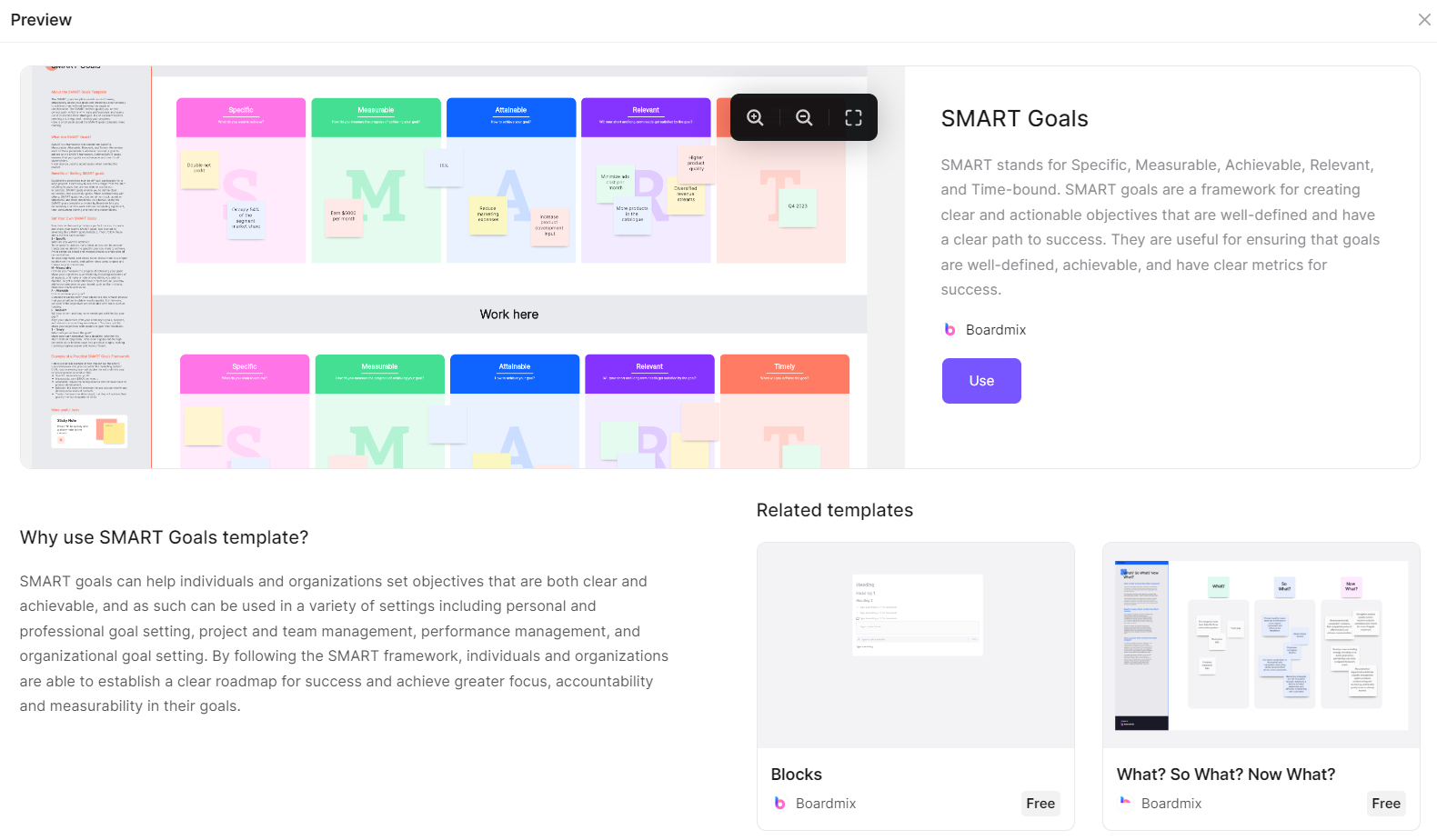
Step 1: Defining the Goal
Start by clearly stating your goal. It should focus on a key area of improvement or a critical objective you wish to achieve. For instance, "Increase quarterly sales."
Step 2: Making it Specific
Now, narrow down the goal into a specific action, outcome, or improvement. Instead of simply saying "increase sales," specify the goal as "Increase quarterly sales of our new product line by 15%."
Step 3: Setting Measurable Criteria
To ensure your goal is measurable, assign quantifiable measures. This could be a percentage increase, numerical target, or specific figures. Here, we're targeting a 15% sales increase.
Step 4: Ensuring It's Achievable
The goal should be challenging yet achievable. Consider resources, timeline, and current market conditions while setting your target. Make sure you have the team and resources to meet a 15% sales increase.
Step 5: Confirming Its Relevance
Your goal needs to align with your broader business objectives. A 15% increase in sales of your new product line will directly impact your overall revenue and growth strategy.
Step 6: Set a Deadline
Assign a time-frame to your goal for better focus and motivation. In this case, the target is set for the end of the quarter.
Step 7: Utilize Boardmix Template
Now you are ready to input this information into the Boardmix SMART Goals template.
- Sign in to your Boardmix account.
- Go to 'Templates' and choose the 'SMART Goals' template.
- Input your goals into the provided fields.
- Assign roles and responsibilities associated with the goal to respective team members.
- Regularly review progress towards achieving the goal using Boardmix's tracking and reporting tools.
By using Boardmix's SMART Goals Template, you can create more precise and effective goals that are clearly communicated, easily tracked, and optimally aligned with your broader objectives.
Tips and Tricks on Setting SMART Goals for Work
Creating SMART (Specific, Measurable, Achievable, Relevant, Time-Bound) goals can significantly enhance your ability to succeed at work. Here are some practical tips and tricks to guide you in setting effective SMART goals:
- Start with a Clear Objective
Identify a clear, broad objective to base your SMART goal on. This might be improving productivity, increasing sales, or enhancing customer service.
- Make It Specific
Aim to make your goal as specific as possible. Avoid vagueness by pinpointing exactly what you want to achieve.
- Prioritize Measurability
The goal should be measurable so that you can track progress and know when the goal has been met. Use quantifiable indicators, such as percentages or numbers, to establish clear metrics.
- Keep It Achievable
Make sure your goal is realistic given the resources available and the constraints you operate under. It should be challenging but within the realm of possibility.
- Align with Relevance
Your SMART goal must be relevant to your job role, department's objectives, or the company's overarching strategy. If it's not aligned, it may not be worth pursuing.
- Set a Deadline
A time-bound element adds urgency and helps prevent daily tasks from overshadowing long-term goals. Assign a clear deadline or timeframe for achieving your goal.
- Review and Adjust
Goals should not be static; they need to evolve with changing circumstances, new information, or shifts in strategy. Regularly review and adjust your goals as necessary.
- Use a Tool for Tracking
Consider using a goal tracking tool or project management software, like Boardmix, to keep track of your progress and stay organized.
- Share Your Goals
Sharing your goals with your team or manager can offer you valuable feedback, increase accountability, and foster a supportive environment.
SMART goals can provide you with a clear roadmap for success at work. Remember, the SMART framework is a guide; not all goals may fit perfectly into it, but applying these principles can significantly improve your goal-setting effectiveness.









